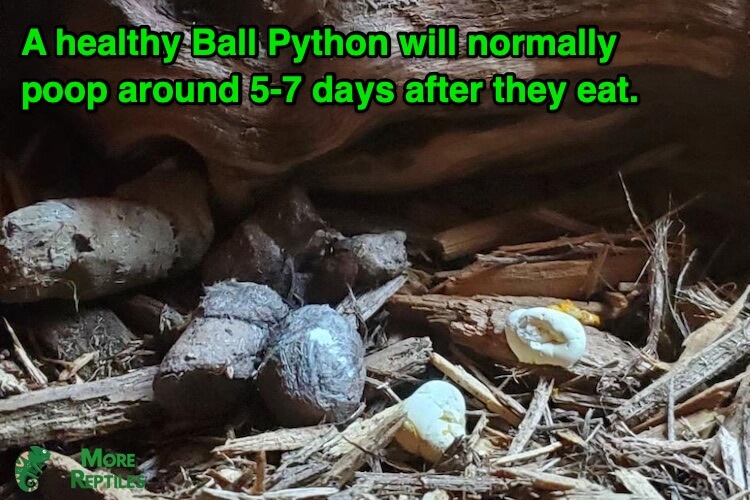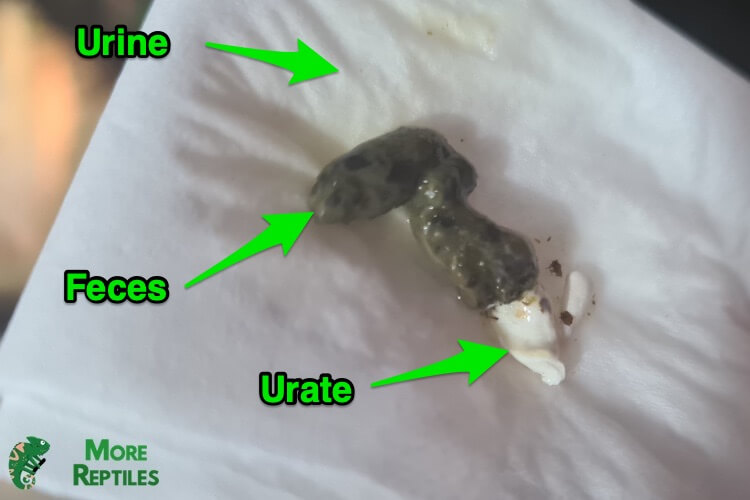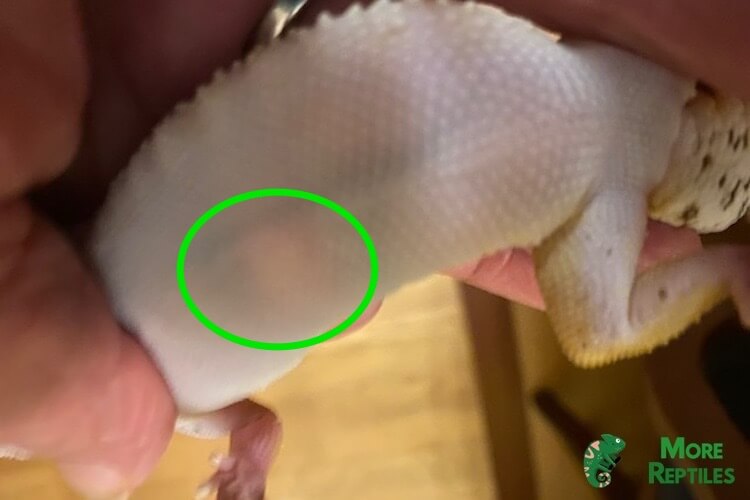For new owners, the infrequent pooping habits of Ball Pythons can be alarming! There are records of some Ball Pythons refusing to eat for over 1.5 years – that’s a long time to go without pooping!
How often a Ball Python poops is directly related to their diet.
Reptiles that eat daily will poop daily, and those that eat every 10-14 days will poop every 10-14 days.
My Ball Python Ivy typically produces one large poop for every large meal she eats. At her ripe old age of 11, she is only producing feces every 18-21 days, normally 7-8 days after eating. This is normal for her, but how do you figure out what’s normal for your snake?
How Often Should Ball Pythons Poop?
A healthy Ball Python will typically poop around 5-7 days after they eat. If they ate a really big meal, like the large rats offered to older pythons, they might not poop until 10-12 days after.
The frequency of Ball Python poop entirely depends on the feeding routine you have for your snake.
Juveniles are typically fed on a 7-10 day basis, so it’s normal to expect them to poop weekly. Young adults being fed every 14 days may only poop twice a month, while adults eating every 21-30 days may only poop once a month.
Ball Pythons on hunger strikes may go months, or even over a year without pooping! This is normal, but if your snake is eating and not pooping, that may be a sign of a serious health or husbandry issue.
What Affects Poop Frequency
Bowel movements can be affected by several factors such as:
- Prey size
- Age
- Hydration
- Shedding
- Parasites
- Husbandry
Prey Size
Younger snakes typically eat smaller prey because of their thin body. This means they will often digest meals faster and therefore poop more quickly after eating. Typically, juveniles will poop closer to 5 days after eating. At this age, they will normally poop 3-4 times a month as they are fed every 7 days.
Thicker or older Ball Pythons eating larger prey, or higher nutrient treats, will typically require more time to digest their meals. It is not uncommon for them to take as long as 10-14 days to produce feces after a large meal. This means they may only poop twice a month.
| # Poop | Prey | |
|---|---|---|
| Juvenile | 3-4 times a month | Adult Mouse or Rat Pup |
| Older adult | Twice a month | Medium-Large Rat, Adult Quail or Newborn Guinea Pig |
Snake Size
Size also plays a role in when a Ball Python poops.
Younger snakes have a higher metabolism, due to their fast growth rate. They will poop sooner after feedings and require meals every 7-10 days to keep up their growth.
Older snakes, like mine, will normally eat one very large meal every 18-21 days. They will spend more time on digestion and therefore take longer to produce feces.
My Ball Python is pretty regular, pooping 5-7 days after her meals. Since I feed her so infrequently, she only poops once a month. She does normally pass small amounts of urates every 2 weeks.
Hydration
Snakes have a very efficient digestive tract that produces urates and poop with minimal water loss. Still, dehydration or low humidity can play a factor in Ball Python poop frequency.
A dehydrated snake may take over 14 days to produce hard stools and urate rocks. This will appear as hard, dry stools with cracks. It may also be in many smaller pieces, rather than one log. You will also notice less urate production, and those passed will be like large rocks, rather than softer chalk.
Related: What Does Ball Python Poop Look Like?
Dehydration can be quickly fixed with regular soaks and better tank humidity.
If you begin rehydration and they are still struggling to poop, or stop pooping altogether, it is time to see a vet.
Shedding
The intense body movements required for a snake to shed can cause them to poop prematurely. This is very common in Ball Pythons that shed soon after feeding; you may notice a smaller poop with more undigested hair or bone than normal.
This is normal, but may be alarming at first because it appears to be a disruption in your Ball Python’s normal pooping schedule.
While shedding won’t cause them to poop less often, it can cause an extra, small or premature stool to be produced. Ivy almost always leaves poop stains around the vent in her shed skin.
Temperature
Tank temperature can play a huge role in fecal production:
- If your snake is too hot, they may produce fast, softer stools.
- If they are too cool and still manage to eat, they may take longer to produce stools or even stop pooping.
Ball Pythons that are too cold may spend all of their time under their basking spot, stop pooping, and start acting lethargic or hiding frequently. In extreme cold cases, try providing 85-90℉ soaks to try to induce pooping before constipation sets in.
Snakes that are too hot will often burrow or try to stay on the cool end of their enclosure constantly. If this is the case, adjust the cool side of your enclosure to 75-78℉ and the warm side to 80-85℉. Also, you should provide a basking spot with a concentrated heat between 90-95℉ for basking.
Parasites
Parasitic or bacterial infections in the digestive tract are one of the main causes of more frequent or abnormal Ball Python poop.
If you notice more than 1-2 poops between meals, runny stools, discoloration, or anything hanging or prolapsed out of the vent, contact a veterinarian for a fecal test. They will quickly be able to determine if there are any medical causes for the disruption in bowel movements.
Why Is My Ball Python Not Pooping?
I begin to be concerned when my snake hasn’t pooped by her next feeding date. Since Ivy eats every three weeks, I start giving her warm soaks around the two week mark if I haven’t seen any poop. I recommend soaking in lukewarm water, around 85-90℉, for 10-15 minutes per session. Do this twice weekly.

Soaking doesn’t always work on its own.
Sometimes feeding will get the digestive tract moving again and induce a bowel movement, but if you haven’t seen anything within five days of the second feeding, I would recommend taking action.
1. Digestion Issue
When working at an exotic clinic, I saw one snake eat a sock, and another eat a towel from its enclosure. I have also seen some impacted with foreign objects like wood chips from their substrate.
The stomach acid of snakes is typically around 1.5-2 pH, making it possible for them to dissolve most portions of any prey (including bones and hair).
If a snake has poor husbandry, hydration, or a health issue, they may struggle to fully digest their food. In some cases, a Ball Python will regurgitate their prey, however, if the prey has been partially digested, it may become an obstruction that requires veterinary intervention.
Related: Ball Python Species Information, Care Sheet & Facts
2. Impaction
Many owners choose to feed prey in the enclosure. I think this is important to allow natural ambush behaviors and reduce stress, but you do need to be careful. Some substrates like cypress mulch have large pieces of bark or wood chips.
Though less common, if you notice your Ball Python eat anything like a large wood chip, seek immediate veterinarian help. Not only can this cause constipation, but it can also cause injury. In extreme cases it may require exploratory surgery or a coeliotomy to remove the object.
To prevent this issue, always feed dry prey items and let your snake strike and constrict in the air.
I used to feed wet prey to my snakes, and once I had one get a large piece of bark stuck in their mouth. Luckily, I was able to pull it out with tongs and it didn’t make its way into the digestive tract.
Always check on your snake during feeding to monitor for these unusual emergencies.
3. Hydration
Dehydration can quickly lead to hard stools and urate rocks. While this normally just delays bowel movements, chronic dehydration can lead to impaction of stool or urates.
You should keep the enclosure between 60-80{a47be734f0df8d7f120a7df290cf380c79376e8356d1aab405383bb23aa6ce67} humidity and use a hygrometer to measure it. A large water dish should also be offered for drinking water. I also like to give Ivy a soak once monthly just to make sure she stays hydrated and has a healthy shed.
4. Temperature
Temperature plays a huge role in digestion.
Temperatures that are consistently near or below 70℉ can lead to a decrease in metabolism. If your snake has recently eaten, it may not be able to produce poop while at this low body temperature. If temperatures stay low for too long, your Ball Python can experience hypothermia and even Cold Shock Syndrome.
Aim to keep the cool side of your enclosure between 75-78℉ and the warm side around 80-85℉.
When to See a Vet
Most Ball Pythons poop between 5-12 days after eating, so anything more than 14 days should be a cause for concern. If your snake goes more than two full feedings, or more than 4-6 weeks, and is still not pooping (even with soaking), I recommend seeing a vet.
A vet will be able to check for impaction related to foreign objects, parasites, or dehydration.
While some can go several feedings without pooping and be healthy, it is easier to address a possible issue when it begins. Do not wait and end up with a more severe problem.
Also, know your snake!
My Ball Python tends to poop about 7 days after eating and has drier stools, regardless of how often I soak her. That’s her normal. Your snake may not be the same, so it is important to monitor for any changes that are outside their “normal.”
Pooping multiple times between feedings, especially if it is softer or liquid in consistency, can indicate a bacterial or parasitic infection. In this case, seek a vet and bring a fresh stool sample to your appointment for testing. To do this, ensure it is less than 24 hours old and has been kept refrigerated.
Key Takeaways
- Ball Pythons typically poop 5-7 days after a meal, but may take up to 10-12 days for larger prey items that require longer digestion.
- If your Ball Python stops pooping but is still eating, it may be constipated due to impaction or dehydration.
- For a snake pooping multiple times between feedings, have your vet run a fecal test to check for intestinal parasites or infections.
- It is normal for them to pass a smaller, softer stool while shedding, even if they have already pooped after their most recent feeding.




